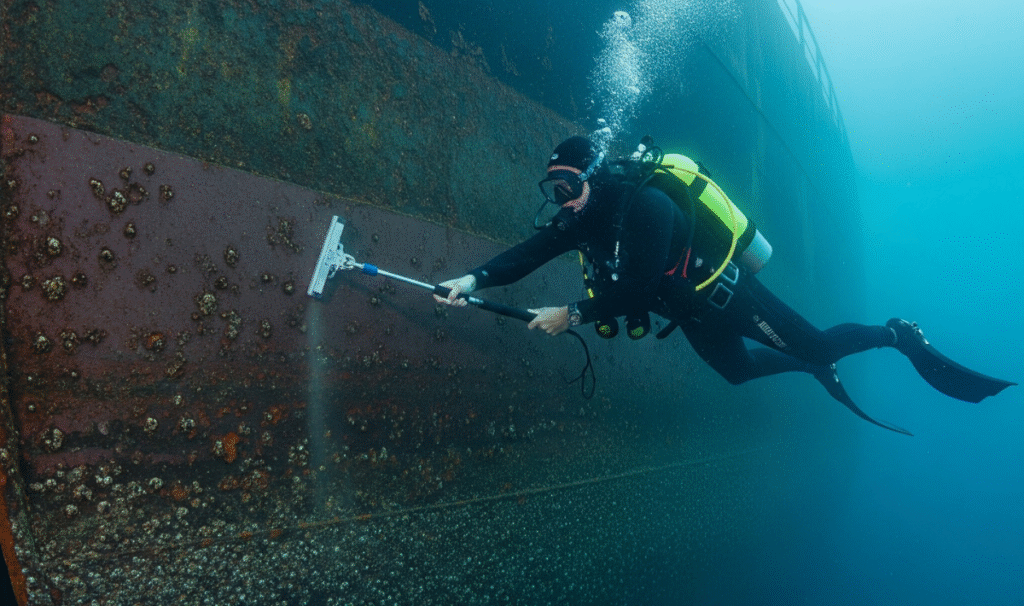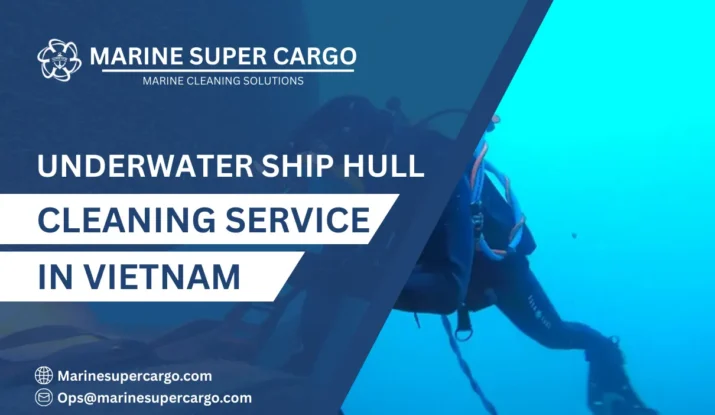When you think of Vietnam, you may picture vibrant ports like Hai Phong, Da Nang, or Ho Chi Minh City. These gateways serve as vital arteries for Southeast Asia’s global trade links. But beneath every shipping giant that docks here lies a hidden challenge: biofouling.
This quiet enemy of efficiency attaches to ship hulls and, if left unchecked, can drain profits, fuel, and even compromise safety. That’s where underwater ship hull cleaning in Vietnam becomes a critical game-changer.
Vietnam is one of Southeast Asia’s fastest-growing maritime nations, with cargo handling volumes expanding significantly at ports every year. Thousands of ships pass through its waters—tankers, bulk carriers, container ships, and fishing vessels. Amidst this busy movement, neglecting hull maintenance is like ignoring your car tires until they bald out—it’s risky and costly.
In this article, we’ll explore the underwater ship hull cleaning in Vietnam: improved fuel efficiency, environmental protection, and vessel longevity with safety.
What is Underwater Ship Hull Cleaning in Vietnam?
Underwater hull cleaning is exactly what it sounds like: cleaning a ship’s submerged hull without bringing it into dry dock. Divers or robotic systems remove layers of algae, barnacles, and shellfish that naturally attach themselves to the hull over time.
- Traditional methods: Divers manually scraped or brushed hulls to clear fouling.
- Modern innovations: Now we see Remotely Operated Vehicles (ROVs), hydraulic brushes, and suction-based eco-systems.
International guidance by organizations like the International Maritime Organization and International Marine Contractors Association (imca-int.com) has improved safety, efficiency, and environmental protection standards, making hull cleaning not just common practice but a mandated element of maritime responsibility.

Boosted Fuel Efficiency and Cost Savings
Imagine jogging with weights tied to your ankles. That’s what fouling does to a vessel. Barnacles and algae increase drag, forcing engines to push harder for the same speed.
For ships navigating Vietnamese waters, this drag translates to massive fuel consumption. Experts estimate biofouling can increase fuel use by up to 40% if unchecked. For operators moving cargo through hubs like Hai Phong, that is a financial nightmare.
Scheduling underwater ship hull cleaning in Vietnam helps vessels:
- Slash fuel bills – smoother hull = less drag.
- Improve speed & schedules – vital in competitive shipping lanes.
- Enhance profitability – lower costs directly translate to higher margins.
It’s like upgrading from a rusty old bicycle to a sleek racing bike—every push goes further.
Environmental Protection and Global Compliance
Cleaner hulls don’t just save fuel—they save the planet. Reducing drag slashes the burning of fossil fuels, which in turn lowers vessel emissions.
The MARPOL Convention, highlighted, makes compliance mandatory for all vessels. Since Vietnam is part of key global maritime trade routes, ships must comply not just for regulatory reasons but also for international reputation.
Key environmental benefits of underwater ship hull cleaning in Vietnam include:
- Lower greenhouse gas emissions – supporting sustainability goals.
- Preventing invasive species – hull fouling organisms can travel from one ocean to another, threatening Vietnam’s unique ecosystems.
- Eco-friendly operations – aligning with global shifts toward greener shipping, encouraged by institutions like iaphworldports.org.
Each hull cleaning operation, if done responsibly and according to IMO guidelines, becomes a small but significant step toward greener oceans.
Longer Vessel Life and Enhanced Safety
Think of your ship’s hull as its armor. When fouling is allowed to sit unchecked, it not only slows down performance but also eats away at protective coatings, starting corrosion. Over time, this weakens the hull’s structure—like rust spreading over a car’s body.
Routine underwater ship hull cleaning in Vietnam ensures:
- Corrosion resistance – fouling removal protects steel hulls.
- Longer coating lifespan – antifouling paints last longer when maintained.
- Enhanced navigational control – clean hulls mean better maneuverability in Vietnam’s busy ports and rivers.
This directly reduces repair costs, maintenance downtime, and most importantly, enhances safety for crew, cargo, and port operations.
Challenges of Hull Cleaning in Vietnam
Like any maritime maintenance, hull cleaning in Vietnam comes with unique challenges:
- Regulatory hurdles – ensuring compliance with international and national rules.
- Environmental concerns – preventing toxins or releases during cleaning.
- Weather conditions – tropical storms and rainy seasons can disrupt scheduling.
Operators must find services that balance safety, environmental care, and efficiency. It’s not just about cleaning—it’s about doing it right.
Technological Innovations in Underwater Hull Cleaning
The world of hull cleaning is rapidly advancing—and Vietnam is gradually adopting these technologies:
- Robotic hull cleaners – controlled ROVs clean consistently and efficiently.
- Eco suction cleaners – prevent waste discharge into the ocean.
- Smart antifouling coatings – make hulls resistant to fouling altogether.
Many practices emphasized by groups like cleanship.co show the shift towards greener and tech-driven hull maintenance. This isn’t just about efficiency. It’s about the future of shipping in the South China Sea and beyond.
Selecting the Right Service Provider in Vietnam
If you’re considering underwater ship hull cleaning in Vietnam, choose your service provider carefully. Look for:
- Certifications – IMO and IMCA compliance are non-negotiable.
- Eco-compliance – ask how they handle waste and debris.
- Experience – local expertise in Vietnam’s waters is vital.
- Technology – ROV and suction systems over old manual scraping.
By asking the right questions, you’ll ensure not just compliance—but long-term savings and safer voyages.

Recap: The Three Core Benefits
Let’s quickly recap the 3 key benefits of underwater ship hull cleaning in Vietnam:
- Fuel efficiency and cost savings – smoother hulls, faster voyages, leaner fuel bills.
- Environmental protection – MARPOL compliance, fewer emissions, safer ecosystems.
- Longevity and safety – corrosion prevention, stable maneuverability, stronger vessels.
Conclusion
Successful shipping in Vietnam isn’t just about cargo and schedules—it’s about caring for what lies beneath. Regular underwater ship hull cleaning in Vietnam ensures your vessel slices through waters like a knife through silk. It saves you money, protects marine ecosystems, and prolongs your vessel’s life.
Simply put, investing in hull cleaning is like sharpening your tools—it keeps your ship efficient, profitable, and safe on every voyage.
FAQ:
Q1: How often should underwater hull cleaning be performed in Vietnam?
Most vessels schedule hull cleaning every 6–12 months, depending on fouling intensity from tropical seas.
Q2: Can underwater hull cleaning spread invasive species in Vietnam?
If performed without safeguards, yes. But IMO and IMCA guidelines minimize risks by controlling debris and waste.
Q3: Is underwater ship hull cleaning in Vietnam cost-effective for smaller ships?
Yes. Even fishing and coastal vessels see measurable gains in fuel efficiency and structural preservation.
Q4: What technologies are becoming popular for hull cleaning in Vietnam?
Robotic ROVs, eco-friendly suction cleaners, and antifouling coatings are leading the transformation.
Q5: Does hull cleaning replace dry docking in Vietnam?
No. It complements dry docking by extending intervals and keeping vessels efficient between dockyard visits.


